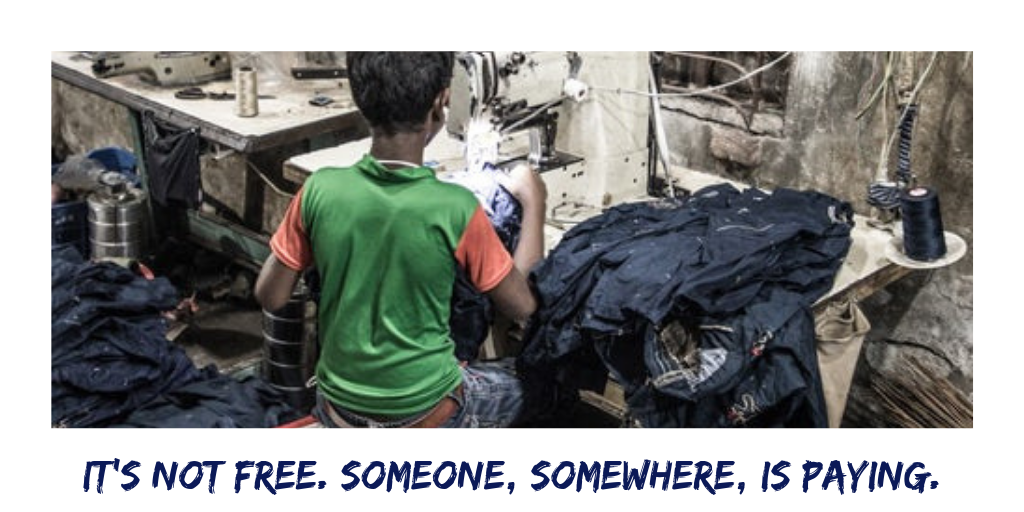BLOG
What is Fast Fashion?
Meaning of Fast Fashion
“An approach to the design, creation, and marketing of clothing fashions that emphasizes making fashion trends quickly and cheaply available to consumers.” – Merriam Webster
We can say that the term Fast Fashion means producing unsustainable apparels at a rapid rate in response to the latest trends.
The apparel produced with the influence of Fast Fashion is usually cheap and trend driven, and their consumers demand of trendy fashion at a low cost. The popular fashion retailer brands create the demand with the help of their marketing strategies to maximise their sales and profits.
How did Fast Fashion start?
Fast Fashion was present in the world since very beginning but its ways have been reformed since the Industrial Revolution. The invention of sewing machine and other machinery for rapid production of clothes are all a part of Fast Fashion. It has rapidly changed from the extraction of raw materials to produce the textile with hand to the machinery of today’s generation which require skilled laborers.
Fashion till mid twentieth century was considered as a luxury, thus the industry focused on four main seasons fall, winter, spring and summer. The designers would plan about their upcoming clothing line way before the season arrived; although this was methodical, it is still followed with two seasons Fall/Winter and Spring/Summer.
Fast Fashion hit its peak after the “boho-chic” wave came in vogue during the mid-2000s.

How is it done?
The retailers produce the textiles and garments at cheap costs to cater to the needs of the mass market. Usually these retailer chains have factories in countries like Bangladesh etc. where the cost of labor is very low and poor labor laws and regulations. (Read: Rana Plaza Tragedy, Bangladesh) Designers of the brands work to produce the designs from the runway for the consumers. After this, they forward the designs to these factories for mass production. The garments are of cheap quality and do not last long in consumer’s wardrobe and hence, end up in a landfill.
Marketing
Mostly, these brands advertise the new styles of clothing at low and affordable rates as compared to the runway brands. The rates attract the consumer more than anything. This also increases the brand awareness among the people (who have no idea about how the brands actually make these garments). They divide the production of certain fashion trends in a span of little time such as seasons or occasions. This attracts the consumers to fulfill their needs according to the time/occasion.
What is the impact of Fast Fashion?
To understand the impact of Fast Fashion, let’s get some context on how these clothes are made.
These big fashion retailers use sweatshops, large factories with hundreds of workers. These sweatshops are mainly located in underdeveloped countries like Bangladesh, where the factories have poor working conditions. The factory owners force the workers to work for seven days a week and give negligible wages to them. With such a low budget, the factory infrastructure and management is equally poor resulting to casualties like fire breaks in the factory. Since 1990, there have been more than 400 deaths due to such casualties in these sweatshops. The women workers are constant targets of discrimination and sexual harassment.
Apart from this labor exploitation, it has proved to be an environmental hazard as well. This rapid apparel production and unregulated factories have increased the use of toxic chemicals to make their clothes look vibrant.
These sweatshop industries emit the greenhouse gases which are equal to gases released during international shipping and aviation combined. According to the reports, 10% of the global carbon print is due to such sweatshop industries.
And the garments produced are of cheap quality and doesn’t last long. Ultimately these unsustainable garments end up in landfill for years. This further disturbs the environment.

Is it sustainable?
Fast Fashion does not approve of sustainability. This is because it does not think of future consequences. It works on the short term goal basis. The companies focus on producing the clothes in huge quantities and buying and selling them in the market. After wearing it few times, its quality degrades quickly, consumers usually discard it and they end up in a landfill. It does not help our environment in any positive way. Instead, it uses our resources more rapidly than any other industry. Also, every time the consumer washes polyester or chemically made garment, it releases microplastic fibres which further causes damage to the water bodies.
Measures to control Fast Fashion
Here are some of the measures through which you can prevent yourself from being a victim of Fast Fashion-
- Research about brands: There are many brands who have come up to be environmentally-friendly and have production process that is sustainable.
- Rent outfits: There is no compulsion to always own the piece of clothing that you post about on Instagram. Try to take clothes on rent. In this way, your wardrobe seems “updated” and you doesn’t harm the environment.
- Thrift stores: There are many charity shops or vintage shops that are available in many cities. Buying such vintage clothes, try to promote “slow fashion”.
- Focus on buying organic fabric clothes: Try to research about brands which sell clothes made up of organic fabrics.
To know about Fast Fashion brands, you can click here.


 WhatsApp us
WhatsApp us
useful post il get to know about bangladesh industries more than fast fashion
keep posting it
thank you
Like!! Thank you for publishing this awesome article.
Thanks so much for the blog post.
I like this website very much, Its a very nice office to read and incur information.
These are actually great ideas in concerning blogging.